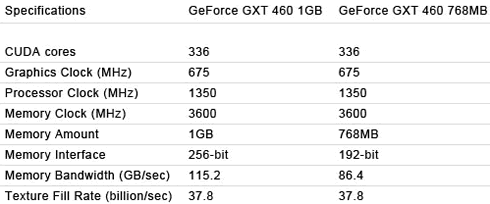1. About the GF104-powered Nvidia Geforce GTX460 Series
Nvidia is ready to effectively compete with AMD/ATI with the new GeForce GTX460 graphics card. The new card is based on a new Fermi chip, the GF104, which looks very promising and may be able to position the GeForce GTX460 on the top of the graphics solutions at the $200 price range.
Nvidia released the first Fermi-based solution earlier this year, with the fully-featured GTX 480 solutions based on the company's first generation Fermi chip, the GF100. The chip performed quite well in a high-end graphics solution but Nvidia decision to use the GPU in other cheaper solutions forced the company to cut-down GF100 core. This had an immediate impact on the performance of the mid-ranged solutions such as the GeForce GTX 465 released in May. As a result, the GeForce GTX 465 lagged behind the rival AMD’s Radeon HD 5850 and also continued to consume more power than its counterpart.
However, the company is back in the game with the latest GeForce GTX460. The heart of the card is the updated GF104 GPU. The GPU features 1.95 billion transistors and packed in an area slightly larger than AMD's GPU used in the 5800 series - which packs almost 1.97 billion transistors. The GF104 has two Graphics Processing Clusters (GPCs) containing 4 SMs each, for a total of 8 SMs adding up to 384 CUDA cores. However, the GeForce GTX 460 is shipped with 1 of the 8 SMs disabled, leaving it with 336 enabled CUDA cores. Despite the cut-down, Nvidia has made significant changes to the design of the SMs for GF104 and the Fermi architecture in general. The company has added superscalar dispatch abilities to GF104, NVIDIA has also made a number of other tweaks to the Fermi architecture for this GPU. All these sound really promising and we look forward to see the F104 Fermi chip in action later on.
NVIDIA launched the $229 GeForce GTX 460 1GB, and the GeForce GTX 460 768MB, priced at $199. The GeForce GTX 460 1GB has 7 SMs and 32 ROPs, with a 256bit memory bus connecting the GPU to 1GB of GDDR5. The core is clocked at 675MHz core, 1350MHz shader, and 900MHz (3.6GHz effective) memory. The TDP for this part is 160W.
The GeForce GTX 460 768MB has less memory than the GTX 460 1GB, but also only 24 ROPs connected to a 192bit memory bus. The shaders remain unchanged, giving the GTX 460 768MB the same compute/shading abilities as the GTX 460 1GB, but only 75% of the ROP capability and memory bandwidth. The clocks are unchanged from the GTX 460 1GB: 675MHz core, 1350MHz shader, and 900MHz (3.6GHz effective) memory.
We have in our labs Inno3D's implementation of the GeForce GTX 460 768MB graphics card. The card is not overclocked, meaning that its GPU runs at at a core speed 675MHz and the stream processors at 1350MHz. The Inno3D GeForce GTX 460 has 1800MHz memory on a 192-bit bus. Inno3D claims that the card offers up to 4x the DirectX11 tessellation performance of the competition. The card also supports NVIDIA 3D Vision, PhysX, and CUDA technologies.

Below you can see a comparison among Nvidia's Fermi-based series of graphics cards:
|
GeForce GTX 460 (GF104) |
GeForce GTX
465 (GF100) |
GeForce GTX
470 (GF100) |
GeForce GTX
480 (GF100) |
Stream (Shader) Processors |
336 |
|
|
|
Core Clock (MHz) |
675 |
|
|
|
Shader Clock (MHz) |
1350 |
|
|
|
Memory Clock (data rate MHz) |
3600 |
|
|
|
Memory amount |
768~1024MB |
|
|
|
Memory Interface |
192~256-bit |
|
|
|
Memory Type |
gDDR5 |
|
|
|
Below are the full specifications of the product as found at Inno3D's page. The 1GB model retails for about $229, and the 768MB version costs less than $200.

